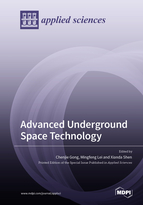Advanced Underground Space Technology
A special issue of Applied Sciences (ISSN 2076-3417). This special issue belongs to the section "Civil Engineering".
Deadline for manuscript submissions: closed (20 July 2022) | Viewed by 36213
Special Issue Editors
Interests: fiber-reinforced concrete; ultrahigh-performance concrete; tunnel engineering; deep learning; computer vision
Special Issues, Collections and Topics in MDPI journals
Interests: multiscale modeling in geotechnique and underground space; railway engineering; durability of tunnel strucutre
Special Issues, Collections and Topics in MDPI journals
Special Issue Information
Dear Colleagues,
The recent development of underground space technology makes underground space a potential and feasible solution for climate change, the shortage of energy, the growing population, and the demands on urban space. Advances in material science, information technology, and computer science incorporating traditional geotechnical engineering have been applied extensively to sustainable and resilient underground space applications. The aim of this Special Issue entitled “Advanced Underground Space Technology” is to gather original fundamental and applied research related to the design, construction, and maintenance of underground space. Potential topics include but are not limited to the following:
- High-performance tunnel and precast underground structures;
- Information modeling of tunnelling and underground space;
- BIM, machine learning, and computer vision techniques in underground construction
- Construction materials of underground structures;
- Tunnel inspection techniques;
- Instrumentation and experimental methods for underground space.
Dr. Chenjie Gong
Prof. Dr. Mingfeng Lei
Dr. Xianda Shen
Guest Editors
Manuscript Submission Information
Manuscripts should be submitted online at www.mdpi.com by registering and logging in to this website. Once you are registered, click here to go to the submission form. Manuscripts can be submitted until the deadline. All submissions that pass pre-check are peer-reviewed. Accepted papers will be published continuously in the journal (as soon as accepted) and will be listed together on the special issue website. Research articles, review articles as well as short communications are invited. For planned papers, a title and short abstract (about 100 words) can be sent to the Editorial Office for announcement on this website.
Submitted manuscripts should not have been published previously, nor be under consideration for publication elsewhere (except conference proceedings papers). All manuscripts are thoroughly refereed through a single-blind peer-review process. A guide for authors and other relevant information for submission of manuscripts is available on the Instructions for Authors page. Applied Sciences is an international peer-reviewed open access semimonthly journal published by MDPI.
Please visit the Instructions for Authors page before submitting a manuscript. The Article Processing Charge (APC) for publication in this open access journal is 2400 CHF (Swiss Francs). Submitted papers should be well formatted and use good English. Authors may use MDPI's English editing service prior to publication or during author revisions.







